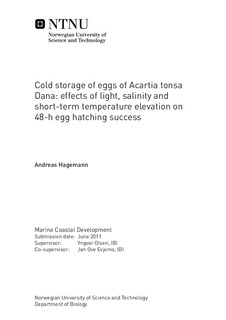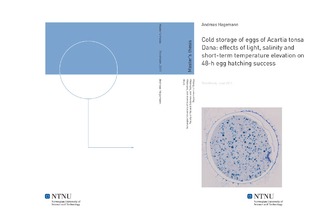| dc.description.abstract | Copepods play a key role in the marine ecosystem where they form a vital trophodynamic link between primary and tertiary producers, and are the dominant prey of many marine fishes during their larval stage. Because of their naturally high nutritional quality, copepods are excellent alternatives to traditional live feed organisms for intensive marine fish production. For aquaculturists, it is important to have continuous access to live feed organisms when rearing altricial fish larvae. Cold stored subitaneous copepod eggs are highly relevant as inoculum for culturing live food.In the present study, the effects of light, salinity and short-term elevations in temperature on the 48-h hatching success (HS, %) of cold stored (2 °C) A. tonsa eggs were evaluated. A light experiment exposed the eggs to three different environments with respect to light for a period of up to 7.5 months; one treatment exposed the eggs to an artificial light source, the second treatment had eggs stored in complete darkness, and the third treatment had eggs stored under the storage conditions applied at NTNU Sealab (SSC-treatment). A salinity experiment stored eggs in seawater of four different salinities (34, 50, 75 and 100 ) for a period of up to 7.5 months to evaluate if this was beneficial for long-term cold storage of A. tonsa eggs. A short-term temperature elevation experiment was conducted in order to simulate shipping conditions with insufficient cooling for consignments of A. tonsa eggs. Cold stored eggs were exposed to temperatures elevated to 9 and 17 °C for 12 and 24 hours, with and without oxygen present in the storage media, whereupon they were put back in cold storage for a period of one week before determining the HS.The results for the light experiment showed that light had a profound negative effect on the HS of the cold stored A. tonsa eggs. No hatching was observed for eggs that were stored under constant light after 3 months of cold storage. Eggs stored in darkness showed a significantly higher HS at the final sampling of month 7.5 compared to the SSC treatment, and less dispersion in HS between the replicates throughout the experiment. The salinity experiment showed that the eggs could be stored in seawater with a salinity of 50 for up to 3 months with a high HS, whereas storage in seawater of 75 and 100 showed a low HS for most samplings and thus proved as a poor cold storage media. The short-term elevation in temperature experiment showed that the HS was significantly affected by the oxygen concentration in the seawater upon a cold storage period of 3 weeks, and that short-term elevations in temperature, up to 17 °C for a duration of 24 hours, did not significantly affect the HS when hatched one week after the onset of incubation. The viability of the hatched nauplii post temperature exposures was assessed in a feeding incidence experiment. It showed that neither of the conducted temperature elevations utterly inhibited the nauplii from feeding. | nb_NO |

